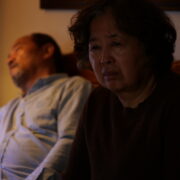DOPESICK “Pseudoaddiction” (S1E4): Compelling Episode Calls For Sympathy

Stephanie Archer is 39 year old film fanatic living in…
Changing the narrative. It’s what keeps survival a possibility. For Dopesick, it keeps the narrative going, it keeps the need for the truth accelerating. For big Pharma, it is the path to success, even if it is at the expense of lives and societal understanding.
In Dopesick, it is the addiction of OxyContin that becomes the focus point. And while the series begins to dive into the roadblock s that old delay charges against Purdue, it also presents the overarching control and influence that would be become roadblocks to recovery.
Crafting the blame
”Pseudoaddiction”, the series’ fourth episode, is gut-wrenching from its opening scene. As the local teens party in the woods, Oxycontin has clearly become the new “cool” drug. And while Purdue had stated that the 12-hour extended-release was nearly impossible to bypass, viewers will watch as these teens simply crush the drug, snorting to get a better and faster high. Instantly the euphoria of the teenage invulnerability is ripped of its illusion, one of the teens overdosing from the pills. And as the group decides what to do to help him but save themselves in the process, they leave his body on the side of the road. It’s a jaw-dropping and intense opening, not only because as viewers we have begun to know these characters but because the horror that plays out is drawn from reality.

From the intensity of the opening scene, time flashforwards from where the film left us in the final moments, Dr. Finnix (Michael Keaton) being offered Oxycontin to treat the pain he is suffering from due to his accident. Now in 1997, viewers are left to watch the aftermath of Oxycontin a year later in both the journeys of Dr. Finnix and Betsy (Kaitlyn Dever). What is immediately important to recognize is not where they are in their addictions, but rather how their addictions are not the same, far from universal. AS Dr. Finnix suffers privately, obtaining pills through his own patients and local dealers, Betsy struggles constantly with her supply – the feeling of withdrawals always just on the horizon.
Michael Keaton shines in a stellar performance in “Pseudoaddiction”, his struggles compounded by the knowledge his character has of what is happening to him. There is the struggle associated with addiction, the want to quit but the inability, neurological chemical changes caused by the drug, and lack of support. Yet, you see him making the steps needed to try and fight against, but further compounded is the lack of knowledge to properly treat, for himself and others, as the constant denial of addiction by Purdue not only is harming an understanding for the addict but is also preventing others from a=obtaining the correct knowledge to combat it. Keaton is the star of this episode, his performance is vulnerable and deeply understanding of his character’s position and struggles.
Roadblocks
“Pseudoaddiction” takes on not only the roadblocks that prevented proper treatment for addicts due to the highly addictive nature of the drug but also the roadblocks experienced by those who would try to take Purdue down and expose the lies they have wielded for economic power and success. As the addict and the doctors prescribing face a lack of knowledge, and a marketing campaign claiming addiction isn’t real, the assistant attorney and DEA agents find they too have roadblocks not easily moved.

As assistant attorneys Rick Mountcastle (Peter Sarsgaard) and Randy Ramseyer (John Hoogenakker) work to make their case against Purdue, their most recent court win finds them buried in mounds of paperwork. Without the resources available, they are burnt out, frustrated that with every day they flip through paperwork looking for anything they can, the addiction and reach of Oxycontin grows. As the assistant attorneys and DEA agent Bridget Meyer (Rosario Dawson) find, they are fighting a wall of misinformation, the presumed safety of the drug overshadowing any cause for concern. The FDA passed it right? It claims to be less than 1% addictive, right? There is new awareness for treating the “pseudoaddiction” that rarely occurs, right?
No matter the wealth of contradicting information the attorneys or the DEA, the prescribing doctors, and even the sales representatives provide to Purdue, the narrative is constantly changing. From breath through pain to pseudoaddiction, breaking down the lie is harder than creating it.
Conclusion: “Pseudoaddiction”
Dopesick at its core continues to show the depravity within humanity, Betsy accepting help by attending local AA, yet finding the support to be hallow and at times, opportunistic. Dopesick shows the addiction Purdue created, asking for empathy from the audience for those who have suffered because of Oxycontin. An engaging episode, Dopesick episode four is going to have you coming back for more – no matter how heartbreaking.
New episodes of Dopesick streaming on Hulu every Wednesday!
Does content like this matter to you?
Become a Member and support film journalism. Unlock access to all of Film Inquiry`s great articles. Join a community of like-minded readers who are passionate about cinema - get access to our private members Network, give back to independent filmmakers, and more.













